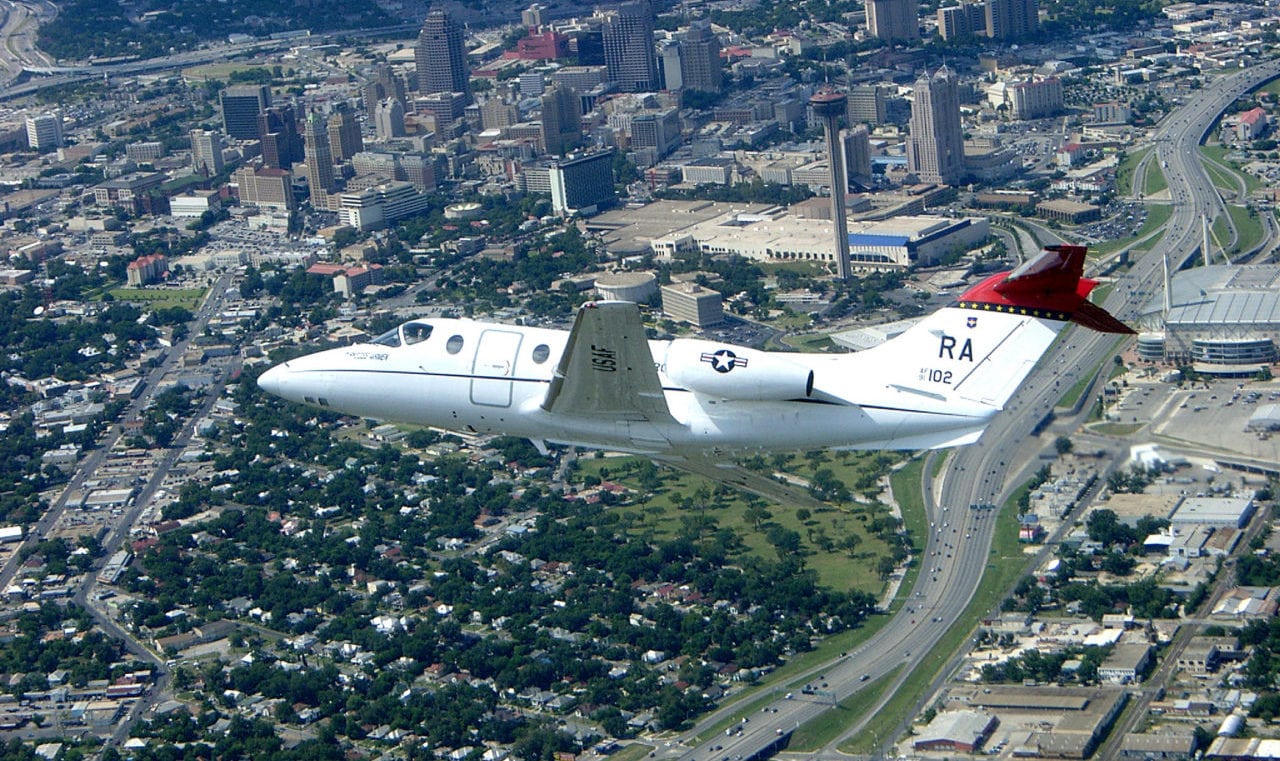
A T-1A Jayhawk from Randolph Air Force Base flies over downtown San Antonio. Photo courtesy of U.S. Air Force
The first T-1A Jayhawk was delivered to Reese Air Force Base in Texas in the beginning of 1992, more than 26 years ago. The U.S. Air Force is determined that the Raytheon-built trainer’s lifespan will extend through five decades, into the 2030s.
In pursuit of that goal, the Air Force awarded a $155.7 million modernization contract to Field Aerospace — with its subcontractors Rockwell Collins, Nextant Aerospace and FlightSafety International — to upgrade the avionics on its entire fleet of 178 Jayhawks, plus 16 flight trainers and 14 part task trainers.
Beginning within the next year, the focal point of the upgrades is Rockwell Collins’ Pro Line 21 integrated avionics system. Rockwell Collins’ Chuck Wade said that the Air Force needed to upgrade with the FAA’s ADS-B Out mandate for 2020 looming and wanted to use it as an opportunity to upgrade and extend the trainer’s lifespan.
“They had to have current technologies in that airplane in order to support that extension of their usage,” said Wade, who was on the team pitching the Pro Line 21 system to the Air Force. “CRT (displays) are not going to do that. They had to get on top of this and the fact that the ADS-B mandate was looming out of there, they were trying to leverage that opportunity to get some technology updates in the airplane.”
Rockwell Collins VP Craig Olsen called the Pro Line 21 “the workhorse of business aviation and many military platforms,” adding that it brings “all the capabilities pilots want for operating in next-generation airspace.”
But the capabilities aren’t the only reason the Pro Line 21 made sense. The Air Force is upgrading the Jayhawks from Rockwell Collins’ older Pro Line 4 system, which makes for a smooth transition. That’s key.
“The system is pretty much ready for them, and that was one of the benefits,” Wade said. “They wanted this thing STC-complete and flying within 12 months of award. Twelve months is not much time in the certification world.”
Wade said more than 700 pilots a year are trained in this program, so the utilization is extremely high. The Air Force can’t afford to have lengthy downtimes for large portions of its fleet.

The Pro Line 21 flight deck in the T-1A Jayhawk. Photo courtesy of Rockwell Collins
The Pro Line 21 makes sense for reasons beyond convenience, though, according to Wade. Pilots that matriculate through that program will go on to fly tankers such as the Boeing KC-46 Pegasus, the Lockheed C-130 Hercules, the McDonnell Douglas KC-10 Extender and the Boeing C-17 Globemaster III. The Pro Line 21’s FMS does a great job emulating those aircraft so the pilots are effectively prepared for their jobs when they finish training. Wade said the Air Force “didn’t want to have to teach them avionics.”
Another facet of the Pro Line 21 that Rockwell Collins likes to tout is its open architecture. Wade said that fits the Air Force’s mission well because it leaves room for future upgrades on things there wasn’t time or money to include now. For instance, he said the Air Force has interest in electronic flight bags and controller-pilot datalink communication capabilities, which can easily be added to the system. A more integrated solution might be lighter or more compact, but adding capabilities would entail taking the whole thing out and re-certifying, which adds a lot of downtime.
While Rockwell Collins is supplying the system and developing line-replaceable units, Nextant is responsible for the integration. It is providing the A-kits and completing the FAA STC for the Pro Line 21 on the T-1A.
The integration will not have much, if any, impact from a size, weight and power (SWAP) standpoint. Wade said that with the strict requirements the Air Force laid out for the equipment and things like number of radios, the companies decided to emulate the Pro Line 4’s layout.
Beyond the 178 Jayhawks, Rockwell Collins is supplying its system for 14 part task trainers and 16 operational flight trainers. FlightSafety International is responsible for the update to the simulators at four Air Force bases and one Naval station.
Choosing the Pro Line 21 for the Jayhawk puts the Air Force in good company. Rockwell Collins said the system has been fielded on more than 5,000 aircraft, and it still comprises 40% of the companies’ flight deck sales despite its first version debuting nearly two decades ago.
Field Aerospace said all installation work will be performed at its Oklahoma facility and is expected to be completed by 2025.
Currently, American T-1A Jayhawks are stationed at multiple bases in Texas, as well as locations in Florida, Mississippi, Oklahoma and Alabama. There aren’t any at Reese anymore. By the time they reach their 2030 life expectancy, they could be in different places altogether. The Air Force has ensured that they will still be in service to train pilots. The modularity of the Pro Line 21 system means that further upgrades could push that date even further.